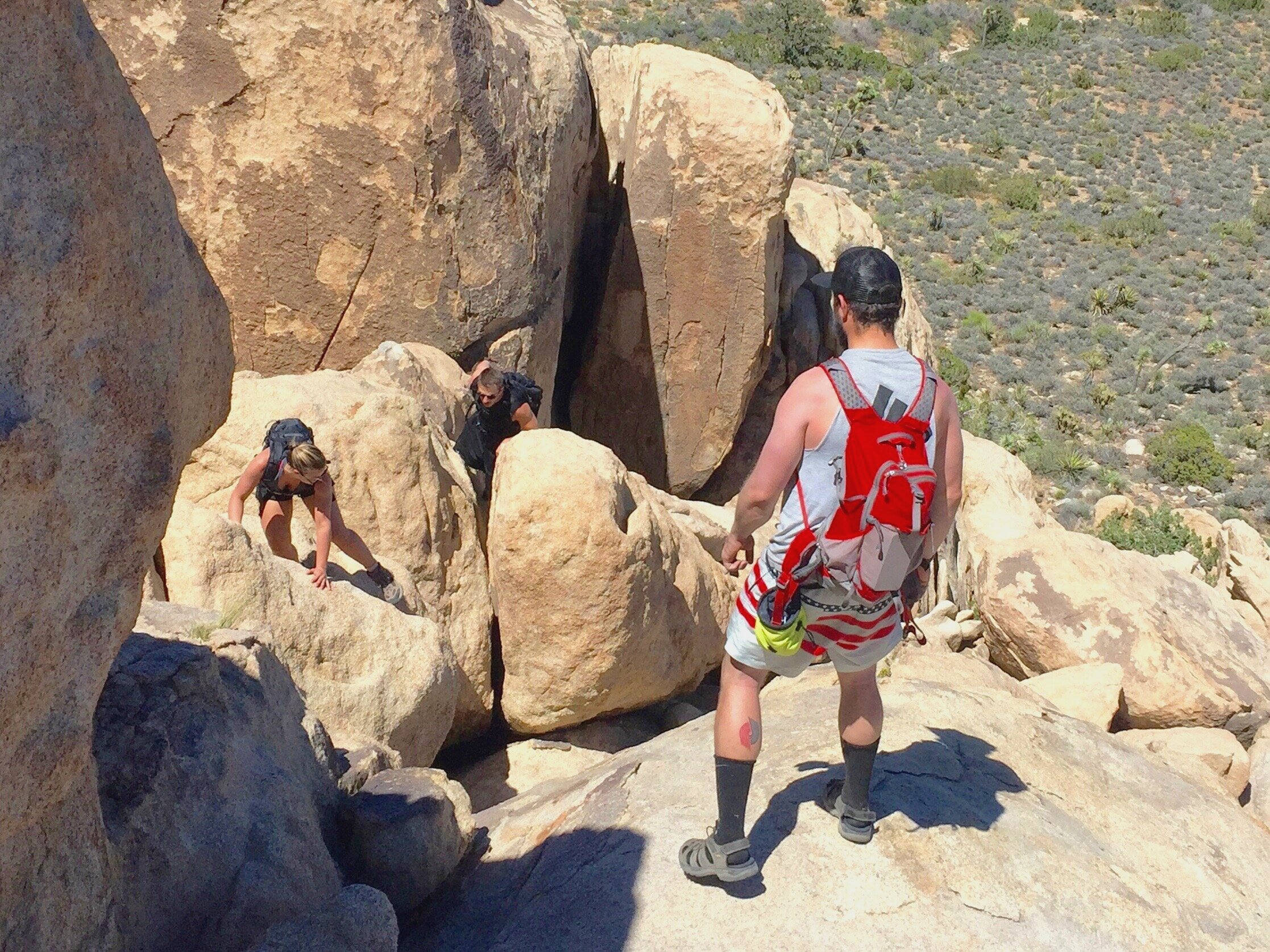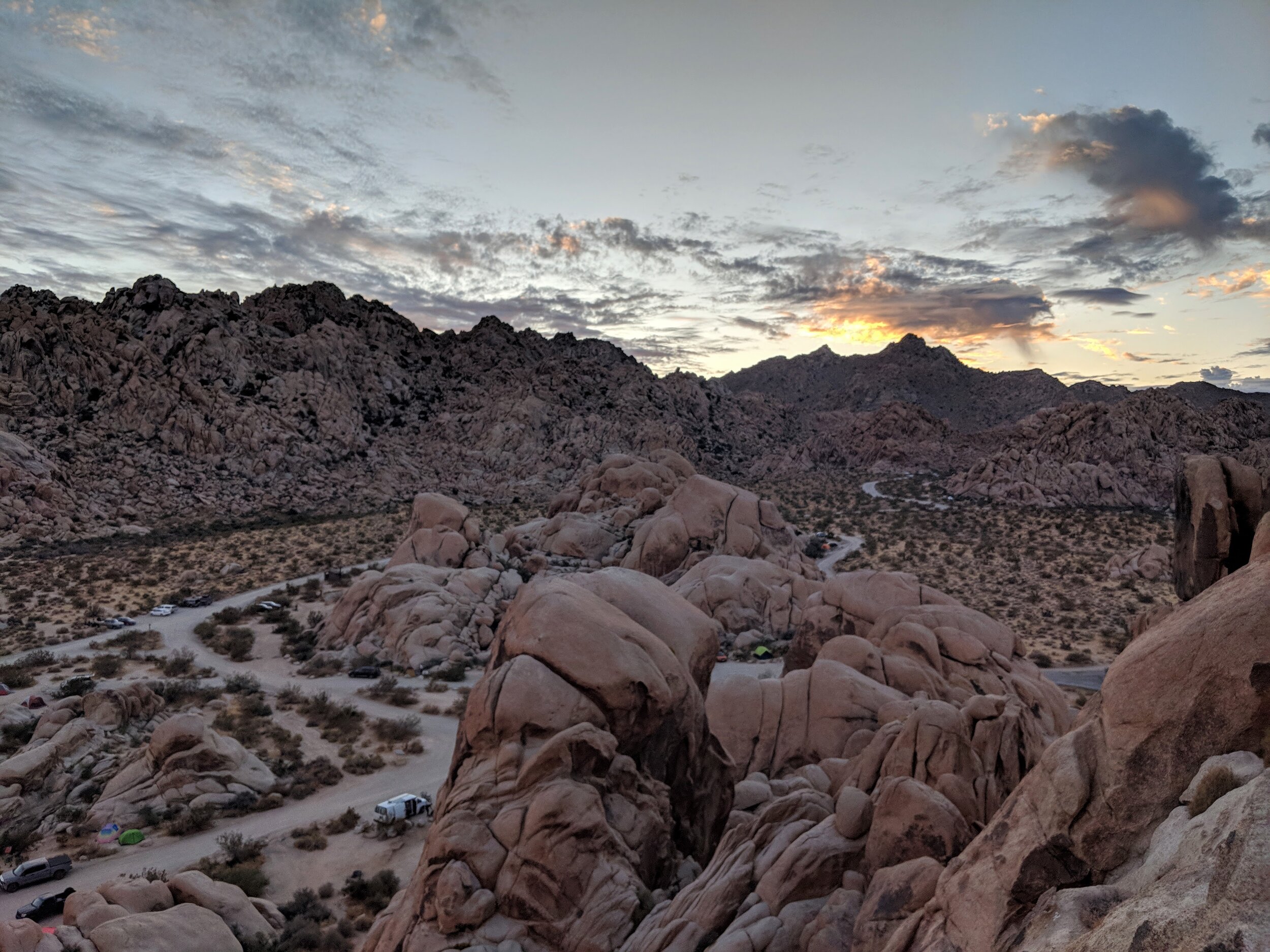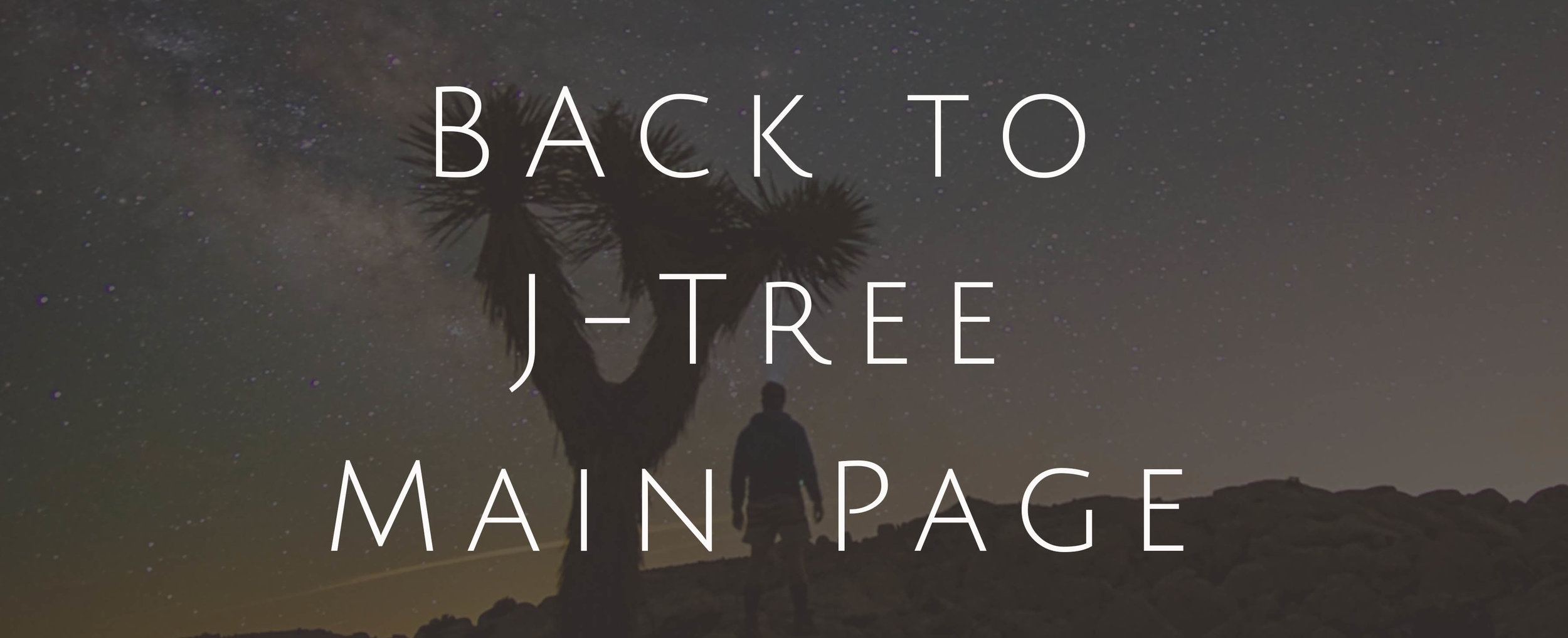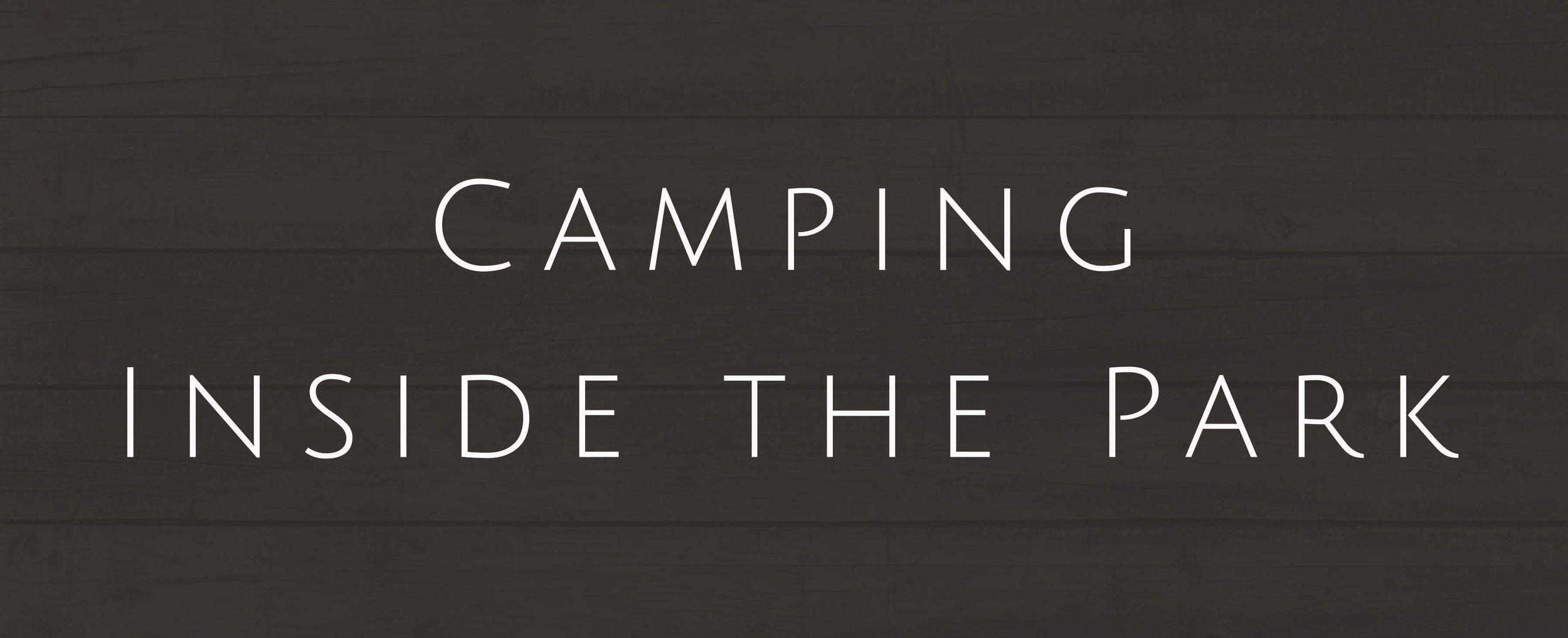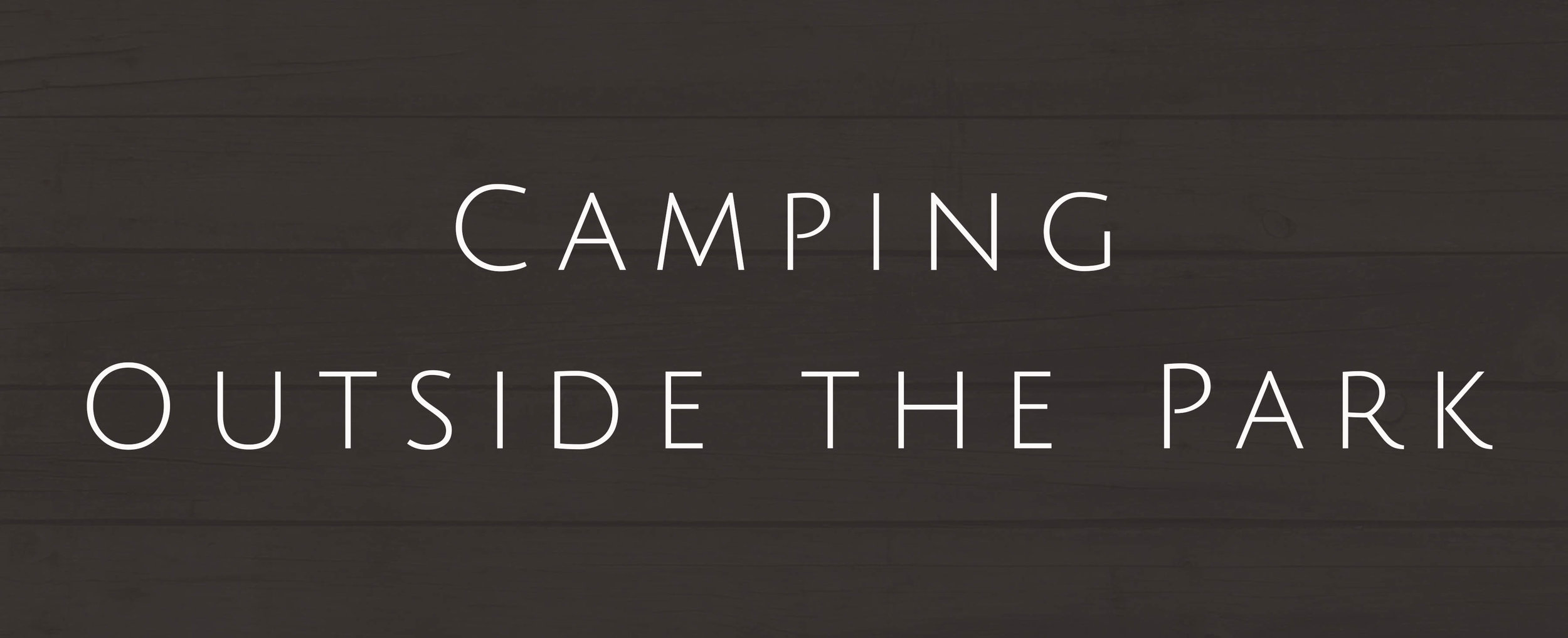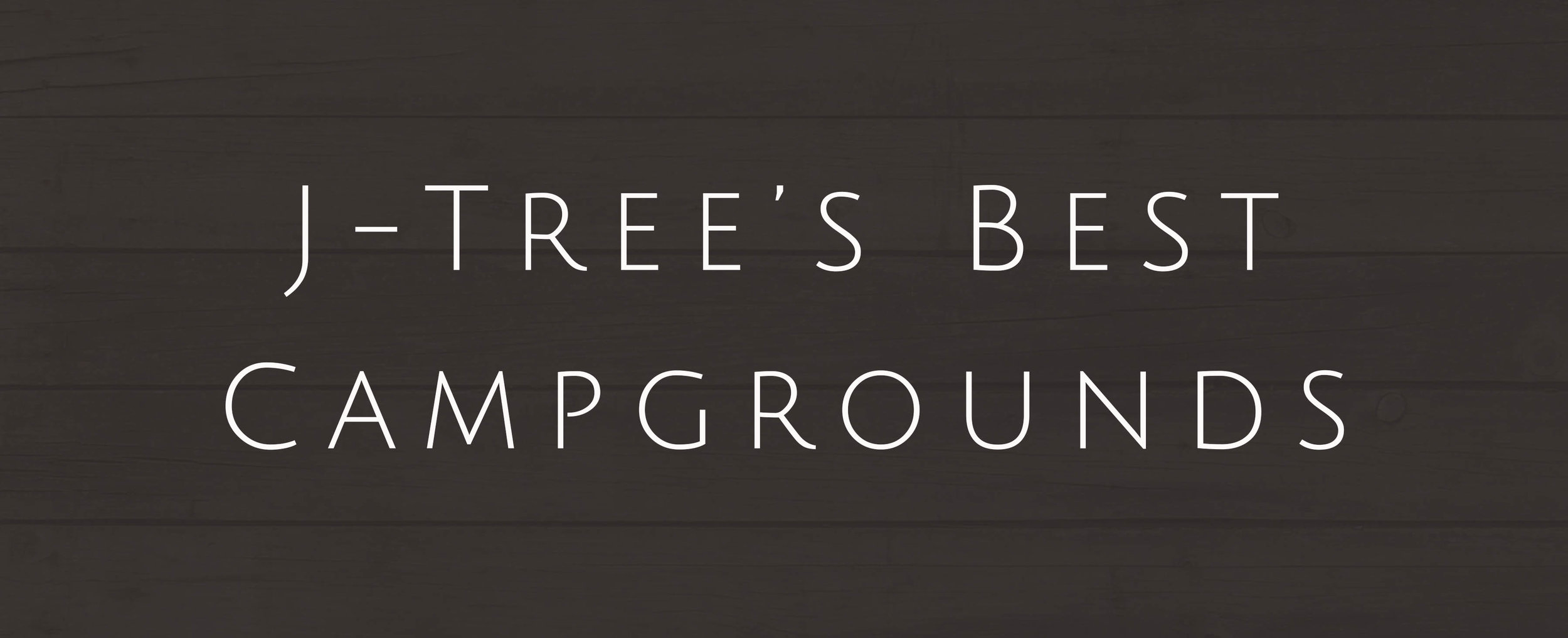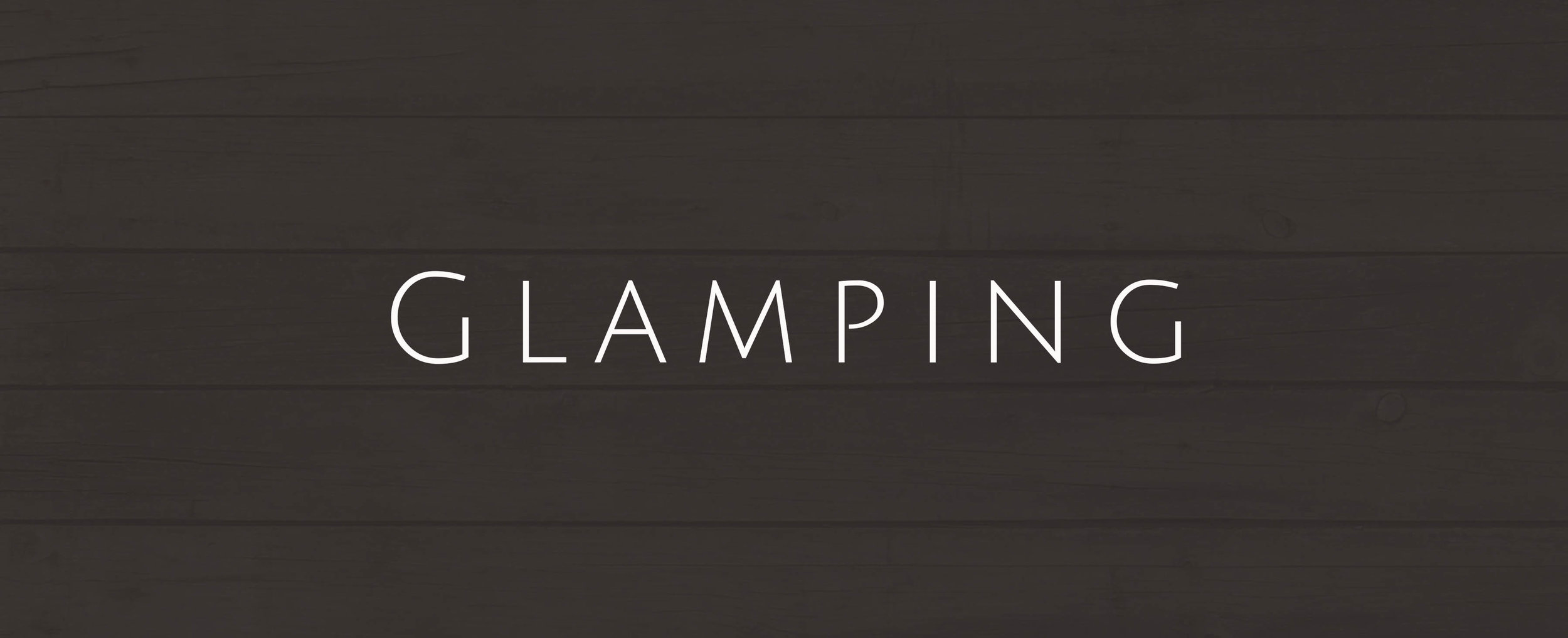Your Ultimate 2021 Guide to Camping at Joshua Tree National Park
Joshua Tree in 2021
For even more info on Joshua Tree trip planning, check out our article on The Four Essentials of a Mind Blowing Joshua Tree Experience.
Get an edge on the crowds at Joshua Tree
If you’re here, you’ve probably been just as frustrated with the crowds at Joshua Tree National Park as I have.
With so many people vying for a limited number of hikes, campsites and climbing routes, a spontaneous weekend trip can easily turn into a frustrating traffic jam—the kind you were looking to escape to begin with.
This popularity in mind, any Joshua Tree fanatic could tell you that locking down a solid campsite could be the absolute most important part of your trip planning.
That’s for a few reasons:
An epic campsite will elevate your entire experience here. There’s just something about seeing the light of your campfire flicker against the side of those iconic boulders that elevates this entire experience to another level (the difference is night and day….get it?).
The BLM camping around the park has its advantages, but in this area is nowhere near as memorable as the park itself.
The limited number of campsites within the park have been harder to lock down every year.
The park itself is remote, requiring a long-ish drive for anyone coming in/out of town each day.
In the guide below, we’ll break down every single camping option, both in and around the Joshua Tree National Park area.
We’ll tell you exactly when & how to snag that big, beautiful campsite you have your heart set on. You’ll also know how to smoothly navigate worst-case scenarios when the park is crowded during your spontaneous Friday afternoon trip. What else is the internet for, after all—am I right?
Our ultimate goal is to see the people who are willing to plan more effectively end up with better campsites. In our experience, those are usually people who care more about the park and ultimately treat it with more respect.
If you are new to the park…
Keep these two points below in mind, and let them guide your decision-making while you’re setting up your trip.
1) Joshua Tree is HOT in the summer. Unlike other national parks, Joshua Tree’s peak season is not its summer months. Think the exact opposite, actually.
Generally anytime between early June and mid September, daytime highs in the park are going to run well north of 100°F. With very little shade and zero water, the park is a brutal and unforgiving place to be in the heat.
For that reason, Joshua Tree’s busy season starts in the fall, remains busy through the winter and peaks again in the spring. By late May, this place is a toaster oven.
2) J-tree is really popular these days, and will require extra planning as a result.
During peak season (spring & fall), the park’s 300+ campsites are usually full for the weekend by Thursday afternoon…sometimes even earlier.
That means if you’re coming in on a Friday night without a reservation, there’s a high chance park rangers will be turning you around at the gate and pointing you toward an open field in Twentynine Palms. Even worse, if the park entrance rangers have gone home for the night, you’ll waste a lot of time driving around at night to find out the hard way. Not an ideal way to start out a National Park weekend.
Campground info & amenities
JTNP contains nine campgrounds within its wide boundaries
For this section, refer to the table below:
This table above should give you the general facts about how Joshua Tree campgrounds operate. We’ll cover info on each specific campground below.
Seasonal closures - Most campgrounds remain open year-round, but some close down during the summer off-season (see table for details).
Sites limits - There are over 300 campsites in the park. Each site accommodates six people, with up to three tents and two cars. In our experience, rangers do count tents & cars, and will hassle you when we run over the limit.
Reservations - These days, most campgrounds in the park are available by reservation only during peak season (which we’ll cover extensively in this guide). Hidden Valley, Belle and White Tank are still exclusively first-come-first-served.
Cost - Campsites ranges between $15-25 per night.
Water - Be aware that NONE of the campgrounds in the main park area have running water. You’ll want to plan on bringing ALL of the water you need with you. How much should you bring? Factor at least one gallon per person per day during cold or regular weather, and two gallons per day when it’s hot out (80°F or higher).
Additional details on campground amenities can be found at the Joshua Tree National Park website here.
First the Obvious, Reserving Campsites in Advance is Still Your Best Option
If you have a schedule that allows you to plan in advance, save yourself a big headache! In this section, we’ll show you exactly when, where and how to reserve your Joshua Tree campsite.
Campgrounds requiring reservations during peak season
The campgrounds below all require reservations during peak season (September - May). Exact open & closure dates may vary year-to-year and are posted online, but the reservation period essentially spans from Labor Day to Memorial Day of the following year.
RESERVATION CAMPGROUNDS (SEPTEMBER - MAY)
Jumbo Rocks
General info | Campground map | Online reservations & photos
Ryan
General info | Campground map | Online reservations & photos
Indian Cove (north entrance)
General Info | Campground map | Online reservations & photos
Black Rock (west entrance)
General Info | Campground map | Online reservations & photos
Cottonwood (south entrance)
General Info | Campground map | Online reservations & photos
Sheep Pass (groups only)
General Info | Campground map | Online reservations & photos
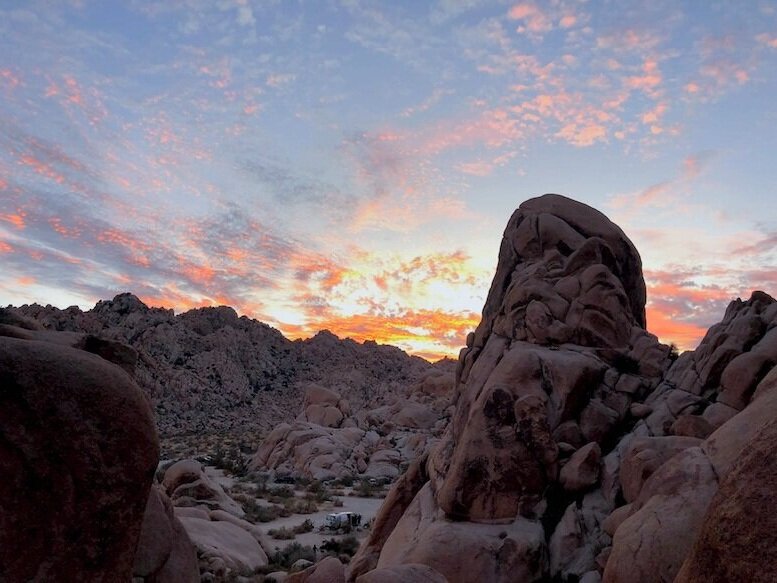
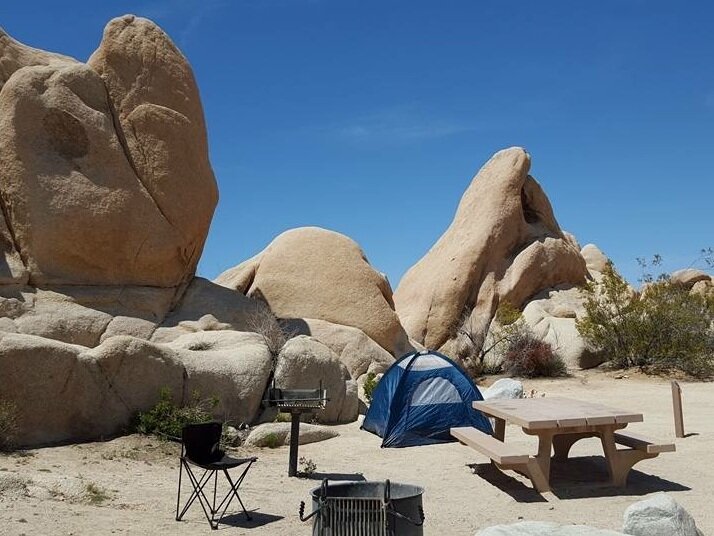
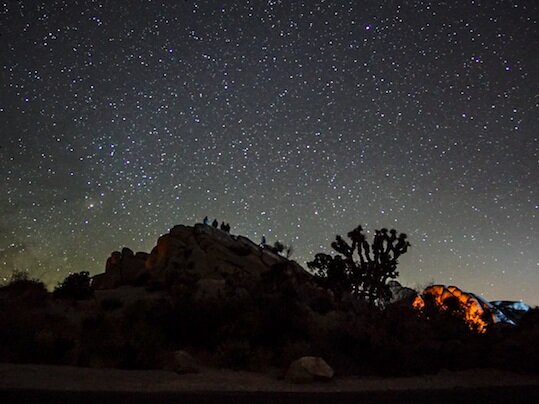

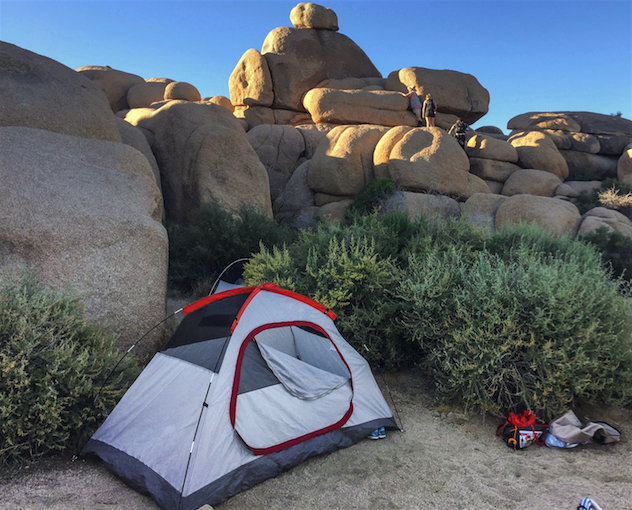
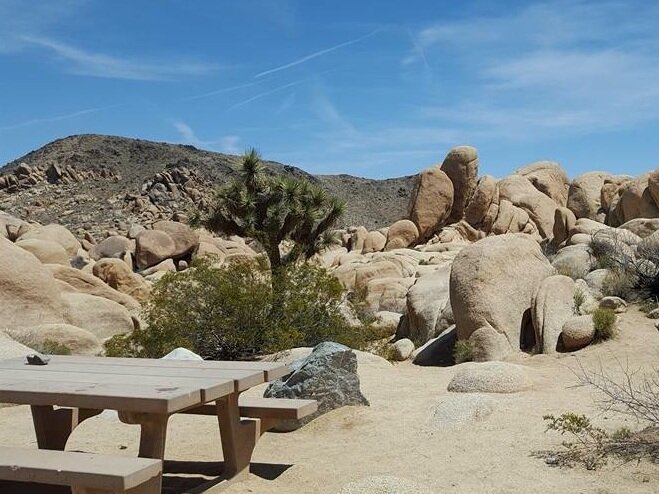
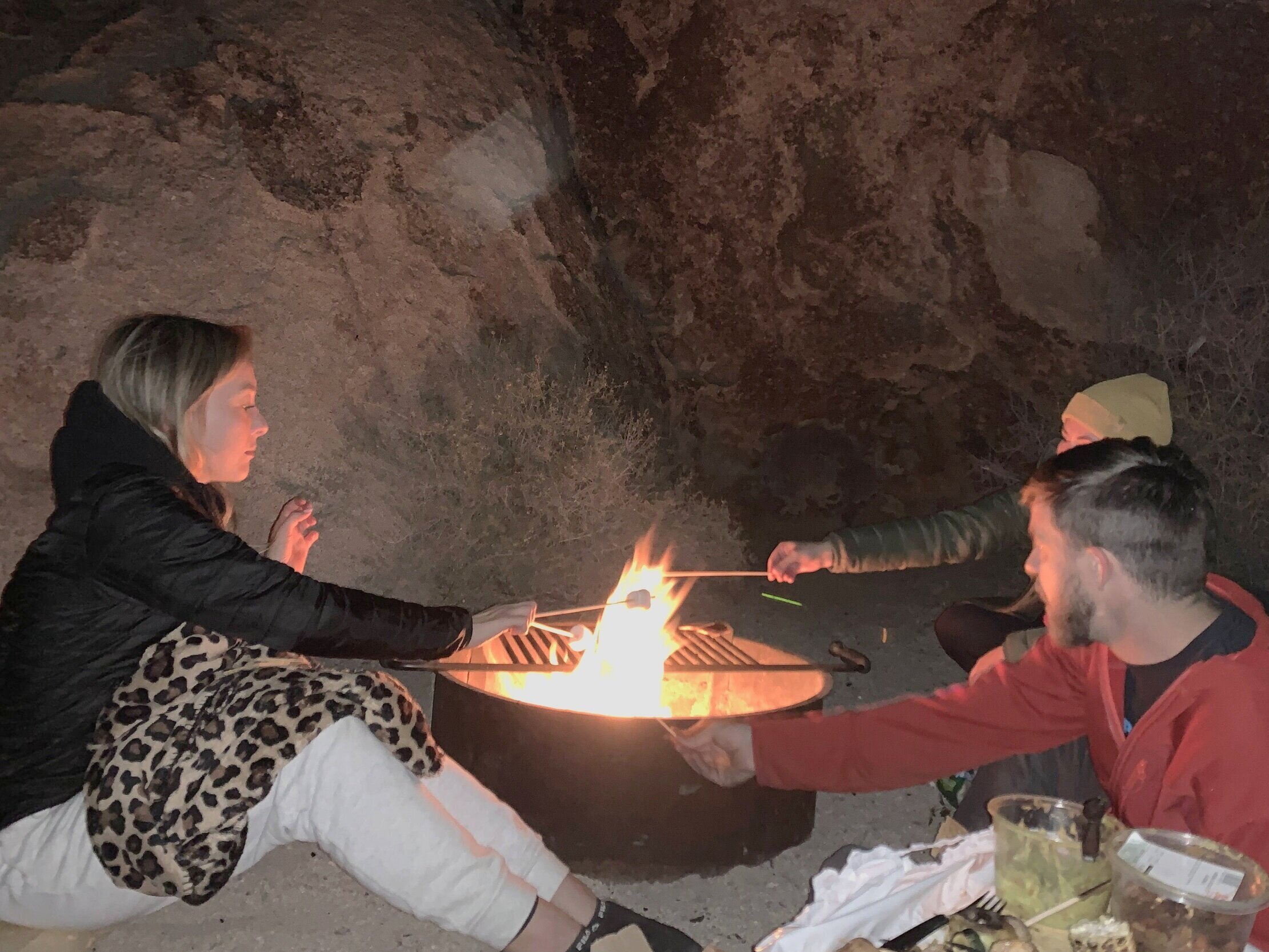
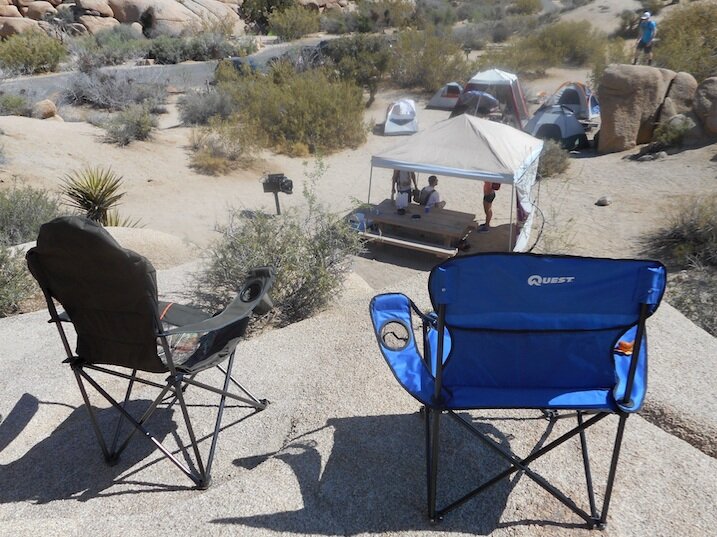
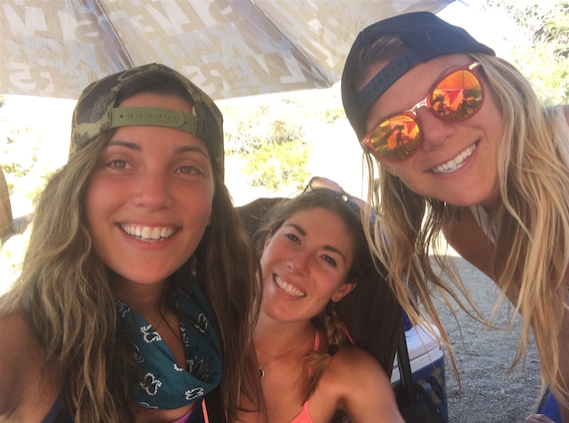
How far in advance do I book?
The six-month rolling basis - Individual campsite reservations can be made up to six months in advance of your desired date and are released on a rolling basis each day.
Unlike other popular camping permits or reservations in California, there’s no lottery or single date & time when the entire season’s supply is released.
Each day, the park’s entire allotment of campsites becomes available for that exact same day of the month six months down the line.
How do I get first pick of the season?
Here’s the real magic—getting your pick of any campsite in the park is as easy as setting your calendar.
Mark these dates!! Set your calendar for a reminder six months before the beginning of the next prime camping season. For fall trips starting in September, I set my calendar for March 1st. For spring trips starting in February, I set it around mid August.
You can obviously pick your own dates. Check out this table below for guidance on possible options:
Booking the campsite - When your six month reminder pops up, follow the steps below:
1) Check Recreation.gov for updates (optional). At the beginning of each season, I always check for any updates or upcoming changes to the reservation process. Occasionally you find something important.
2) Have a desired campground in mind. Every campground in the park has its own reservation page on Recreation.gov, so you’ll want to know your preferred stomping grounds ahead of time and navigate to that page (see the section directly above for links to each campground).
3) Set your exact trip dates. Each day’s campsites are released at 7am PST. So if you want to book a trip starting Friday, March 8, 2022, you should set your calendar to log on September 8th 2021 @7am PST. Sometimes the best spots go quickly, so for best pick, be ready to click at 06:59:00am.
4) Book the trip. All the work is done at this point—booking is the easy part. Just follow the instructions the website gives you. You’ll get a great selection because most people don’t have as much discipline as you do! :) Enjoy your trip!!
Let us do the hard work for you!
To make things even easier yet, download our FREE Spearhead Wilderness Permit Calendar. We’ll send you reminders with detailed booking info via a custom-made Google calendar (iCal and Microsoft work too). The calendar alerts you whenever it’s time to reserve your Joshua Tree campsite heading into each season!
Click Here for details :)
J-tree Campsite Reservation Resources
Joshua Tree Campsite Reservations - Recreation.gov
JTNP Campsite Reservation Phone Line - (877)444-6777
JTNP Visitor Center Front Desk: 760-367-5522
First-come, first-serve campsites: how to snag 'em on crowded weekends
FACT: Most adventures aren’t planned out six months in advance
Let's be honest--planning for trips to national parks six months in advance sucks. I LOVE spontaneous adventures. On top of that, I have no idea what my schedule is going to look like in six months, especially with work.
The massive increase in popularity has made spontaneous trips exponentially more difficult in recent years. BUT, there’s hope!
We’re all about gaming the system over here at Spearhead Adventure. Here are a few hacks for maximizing your chances of getting a site inside the park if your only option to head out is Friday afternoon.
First-Come, First-Serve Campgrounds
OPEN: SEPTEMBER - MAY (peak season)
Hidden Valley
General Info | Campground map
White Tank
General Info | Campground map
Belle
General Info | Campground map
OPEN: JUNE - AUGUST (hot)
Hidden Valley
General Info | Campground map
Jumbo Rocks
General info | Campground map
Indian Cove (north entrance)
General Info | Campground map
Black Rock (west entrance)
General Info | Campground map
Cottonwood (south entrance)
General Info | Campground map
Tip #1: Understand J-tree's unique busy season windows
This is an obvious one, but bears mentioning for any first-time visitors.
Any weekend between October and May could potentially give you a headache when finding a campsite on the weekends. Expect first-come, first-served campsites during peak season to be filled by Thursday evening (Friday morning if you’re lucky).
Last November, I talked to a ranger who said the park had consistently been filling up by Thursday night. The guy had been spending his entire Fridays turning cars away.
During peak times of the busy season (early March - mid April and early October - mid November), you may have a hard time finding first-come first-served campsites during the week as well.
Tip #2: Send an early scouting car
This is our best piece of advice—it’s basically a must if you want a weekend campsite in the park for a last-minute trip.
We all know that one friend who can get off work at noon or "work from home" on a Friday when needed. Maybe they simply work a different schedule and have an earlier weekend.
Whoever it is, bring that friend on this trip, even if you haven’t spoken to them in years or hate their guts. You’ll need an early scouting car to leave as early as possible on Thursday (or Wednesday) and snag a campsite for the group. Doing so successfully could make the difference between an epic J-tree campsite and a flat open field off the highway.
Tip #3: Call the ranger station on your drive out there
I keep the Joshua Tree Visitor Center phone number in my phone on speed dial. They can be a great resource! On your drive out, call and ask if first-come, first-serve campsites are full for the weekend.
Visitor Center Front Desk: 760-367-5522
Visitor Information: 760-367-5500
I also recommend calling the campsite reservation line for any last minute cancellations:
Joshua Tree Campsite Reservation Line at (877)444-6777
Tip# 4: Mornings are key!
The best time to find a first-come, first-served campsite is usually in the mornings, as people pack up and leave from the night before.
Friday and Saturday mornings clearly won’t have as many openings as other days of the week. Even still, your chances of scoring an open site are still highest in the morning, knowing that campsites fill up as the day goes on.
Tip #5: Know where the Joshua Tree BLM campgrounds are as a backup plan
If campgrounds are full, or if you just want more privacy, you can find two large collections of public land (BLM) just outside the park boundaries--one by J-tree’s north entrance off Hwy 62 and the other by the south entrance near Hwy 10.
Check out our entire section on details, directions and everything you need to know about BLM camping below.
Tip #6: Backpacking is allowed in Joshua Tree
There’s no quota for backpacking permits in Joshua Tree, and they’re all self-issued at the trailhead. You could show up on a Saturday in April and still get an epic campsite inside the park with plenty of privacy. The catch…you have to work harder to reach it.
Hitting the Joshua Tree backcountry—a hot, resource-poor environment with zero water or cell service—comes with its own set of risks. People have tragically died getting lost on Joshua Tree backpacking trails, so I wouldn't go this route on a whim unless you're an experienced navigator and are prepared to bring ALL of your own water with you. For the same reasons, I also wouldn’t recommend doing this during hotter months.
For experienced backpackers who are well-prepared, I recommend the California Hiking and Riding Trail.
Here are a few backpacking resources to help you:
NPS.gov - Backpacking in Joshua Tree (great resource)
GoneOutdoors - Four Things You Need to Know to Plan a Successful Backpacking Trip in Joshua Tree
Bearfoot Theory - Joshua Tree Backpacking: The California Hiking and Riding Trail
Our Favorite Campgrounds Inside the Park
#1 - White Tank
Open - October - May
Reservations - First-come, first-served only
Sites available - 15
Running water - No
The low down - White Tank is our favorite campground in the park. Unfortunately that's no secret--we had to show up on a Wednesday morning to lock these down for the weekend. Any of the spaces in this campground are fantastic. You've hit the jackpot if you can lock down site #4.
Why we love it
Easy access to Arch Rock and the beautiful labyrinth of boulders that surrounds it
The best place in the park to see the stars at night
Plenty of space between sites and and a giant backyard
Ideal for a full moon adventure & glow stick cave party : )
For a good time, have a glow stick cave party
The garden of boulders behind White Tank campground sets the stage for a perfect midnight adventure, where you'll wander through a dense garden of morphed & twisted coral shaped rock formations. At certain moments, you'll look up and realize how fascinatingly creepy it looks....like some kind of midnight 3D Picasso painting.
Scout the area out during the day and you'll find caves made by the empty space under piles of impressively large boulders. Add a big crew of friends plus some glow sticks and music, and you've got a big J-tree dance party under the stars with no one around to complain about the noise. Note: pick up any trash you bring, and always leave no trace!
Photo Credit: Brant Carnwath
#2 - Jumbo Rocks
Open - All year
Reservations - Yes
Sept. 4 - June 1 - Reservations allowed: Official campground information | Online reservations & photos
June 2 - Sept. 3 - First-come, first-served only
Sites available - 124
Running water - No
The Low Down - We’ve stayed the majority of our visits at Jumbo Rocks and always have a great time here. Packed full of Joshua Tree's legendary boulders, Jumbo Rocks is not only one of the most beautiful campgrounds in the park, it's also the largest. You’ll find plenty of gorgeous campsites here. The truly exceptional spots are located near the front of the campground, with some of the most spacious sites toward the back.
Unfortunately, at most of these campsites (in typical J-tree fashion), you're going to be crammed in close to your neighbors. For climbers, Jumbo Rocks isn’t quite as close to most of the good climbs as other campgrounds.
Sites #68-69 - A multi-tiered Pride Rock style campsite with a fire pit directly at the base. The flat, elevated rock surface overlooking the fire easily fits 4-5 camping chairs for perfect night sky viewing. We also brought a 100 pack of neon glowing bracelets, which we decorated the site with (again, leaving zero trace). If you're clever and have trad gear, there's also room for a hammock, pop-up tents and some camping rugs.
Why we love it
Iconic J-tree look & feel
No lack of beautiful campsites
Better star gazing on this side of the park
You can hike & explore right from the campsite, and if you’re in the mood for a late-night jaunt, there’s a trail going all the way out to Skull Rock
#3 - Hidden Valley
Open - All year
Reservations - first-come, first-served
Sites available - 44
Running water - No
The low down - Camp right where all the action is at Hidden Valley, especially if you’re a climber! This campground lies right in the heart of Joshua Tree and is surrounded by endless options for hiking and climbing.
The only downside (and it’s a big one)—due to its prime location and popularity among climbers, this campground is the hardest place to snag a campsite, and the best sites are always taken.
We we love it
Legendary Joshua Tree campground that’s centrally located in the best part of the park
Surrounded by epic climbing routes
Walking distance to a number of great hiking/scrambling areas, including the Wonderland of Rocks
Walking distance to our favorite adventure, the Chasm of Doom
Younger campers and less families = cooler neighbors (sorry families, it’s true though)
#4 - Indian Cove
Open - All year
Reservations - Yes
Sept. 4 - June 1 - Reservations allowed: Official campground information here | Online reservations here
June 2 - Sept. 3 - First-come, first-served
Sites available - 101
Running water - No (but you’re 10 min. from town)
The low down - Indian Cove is a totally underrated site compared to other campgrounds like Jumbo Rocks and Hidden Valley locations that usually get all the attention. It’s located outside of the park near the main entrance on Park Blvd. at the northern gate, but that doesn’t mean you’ll be getting any less Joshua Tree goodness. Indian Cove is surrounded by a literal mountain range of granite that looks like a high desert paradise whenever you look around.
Indian Cove campsites are surrounded by climbing routes in every direction, and as you’ll notice in the photos below, has that classic Joshua Tree vibe!
Why we love it
Beautiful scenery and great campsites all over
It’s a big campground, so more availability
One of the best campground for climbers—there’s great routes all over the place
Less crowded than the park itself, especially with respect to the climbing routes
Starting point for great hiking & backpacking trails
Close to the towns of Twentynine Palms and Joshua Tree
Closer to water & cell service
Dispersed Camping Outside the Park (BLM)
With Joshua Tree, I usually shoot for a campsite within the park if available. They’re just that cool. In the worst case scenario where the park is full—or if you simply want a little privacy—it's good to have a back-up plan.
Fortunately, the surrounding area outside the park has enough BLM land to support even the largest crowds. I've mapped out several options below to make sure you're never left empty handed when you're in the mood for a spontaneous weekend getaway.
What is dispersed camping?
Dispersed camping (aka boondocking) is essentially free camping on open land, and it comes with its own set of pros and cons. Also known as primitive camping, it is most commonly available on publicly-owned U.S. taxpayer land, also referred to as BLM land (Bureau of Land Management).
You won’t find dispersed camping areas anywhere within national parks, city areas, private property, protected wilderness, etc. Camping at a designated campground, for example, is not dispersed camping. The links below (as well as Google) can tell you where to find said land around each U.S. city area and how to best preserve the land you’re staying on.
What are the advantages? No crowds, no costs, no formal campgrounds, no reservations. Since they are (by definition) located outside populated city limits, dispersed camping areas are almost always exponentially more beautiful, remote and exciting to stay at—you’re actually having the authentic outdoor experience that you came for (imagine that). Talk to any experienced outdoorsman, and they’ll tell you that dispersed camping is the only option they look for on an adventure.
And now, the drawbacks. It’s real outdoor camping. That means zero amenities whatsoever. Restrooms, running water, picnic tables, grills for barbecuing food—you have to bring all of that swag yourself. Yes, you’ll be digging holes in the ground to poop (or finding restrooms in town). You’ll be responsible for your own fire safety and packing out your own trash. Because you’re staying in remote territory, roads in & out aren’t always paved or accessible for low-clearance vehicles. It means that people might not be around in case of emergency, and in the same context, it also often means no cell phone service.
With a great experience comes great responsibility. Know your comfort level in the wilderness and choose wisely. The best campsites I’ve ever stayed at have ALL been on primitive/BLM land. At the same time, for brand new outdoorsmen and women with families, this may not be the best option. If you decide to go and you’re new to this, read and have a copy of the instructions below.
Remember to LEAVE NO TRACE—be respectful of the land, and only bring in what you’re able to pack out.
Resources
Bureau of Land Management - Maps for Every BLM Territory in the US
Gear Junkie - Camp for Free on Public Land: Dispersed Camping 101
Ramos Law - BLM Camping Rules 101
Bureau of Land Management - Laws & Regulations (complete 120 pg handbook)
Now per the Joshua Tree area—when should I opt for dispersed camping?
Aesthetically, the Joshua Tree BLM campgrounds are nothing spectacular, especially compared to the granite-stacked campsites inside the park. However, there are certain situations where BLM camping is a helpful option to have in your back pocket.
Here are some of the pros & cons:
Pros - completely free of charge, guaranteed availability, much more privacy, close to amenities of nearby towns, and cell phone service is actually available here (whereas the park itself is a black hole of cell service).
Cons - the campsites are bare and less interesting, located outside park boundaries (requiring drives in/out each day), and have no access to bathrooms, running water or trash pickup. We won’t kid you—it’s an open field you can camp in.
When it’s best to use them - BLM land is great to have as a back-up if you ever want to head out for a spontaneous weekend in Joshua Tree and don’t have a reservation. It’s simply nice knowing you’ll always have a close free place to stay if you can’t get a site inside the park.
In general, we use them as overflow when the rest of the park fills up, when we’re looking for more privacy than the tightly-packed campgrounds in the park, when we want the freedom to be loud and crazy at night, and when we absolutely need cell service for any reason.
Where are the dispersed camping areas near Joshua Tree?
The Joshua Tree area has two BLM campgrounds. I’ve included addresses to both locations below, which can be plugged straight into Google Maps.
BLM Camping North of Highway 62
66455 Broadway
Joshua Tree, CA 92252
BLM Camping South of Cottonwood Spring
Cottonwood Spring Rd.
Chiriaco Summit, CA 92201
Which campground should I choose?
It depends on where you’ll be playing in the park. Neither location is spectacular, but I personally like the north spot due to it’s proximity to town and the main park entrance.
The BLM north campground off Hwy 62 (option 1) is much closer to the action. It’s located just off the main highway between the towns of Joshua Tree and Twentynine Palms, near the Indian Cove campground. It’s located just 15-20 min. driving time from the Joshua Tree National Park main entrance on Park Blvd. heading toward Hidden Valley.
The BLM south location on Cottonwood Spring Rd. (option 2) is a little more private and interesting, but it’s over an hour each way to Hidden Valley as opposed to 20-30 min. from the north location. If you’re planning on checking out some of the park’s southern features, like the Lost Palm Oasis trail, I’d highly recommend the southern BLM camping area.
Camping outside the park - additional resources
NPS.gov - Camping Outside of the Park
Glamping
Overview
Glamping gets a bad rap. Forget the Coachella-loving stereotypes that make people roll their eyes when they hear the word “glamping.” If you can snag a cool spot and don’t mind paying for it, you can find some bad ass experiences out there.
Joshua Tree is one of the best places to find such hidden gems. I’ve included a few below. Be prepared to book WELL in advance.
Private campgrounds on HipCamp
I haven't checked out any of these campsites in person, but several of them look like great alternatives to the BLM lots if you don't mind driving a little further and spending a little extra.
HipCamp - Think AirBnB for glamping and cool private campsites (this site has some insanely cool private campsites near Joshua Tree--definitely worth checking out)
HiCamp Journal - Top 7 Joshua Tree HipCamp rentals
Check out these insane Airbnb rentals
Even as a die-hard camper, I’ll admit, these Airbnb places are getting insanely cool around the Joshua Tree area.
Here are a few stunning places to check out if you already happen to be browsing…
Airbnb - Desert Tipi & Natural Pool
Check out these great Joshua Tree Adventures
JOSHUA TREE TRIP PLANNING
The Four Essentials of a Mind-Blowing
J-Tree Experience
HIKING IN J-TREE
Our Top Five High-Adventure Hikes
Plus Three Classic Mellow Strolls
CLIMBING IN J-TREE
A Review of Our Favorite Crags
for Climbers Who Are New to the Park







